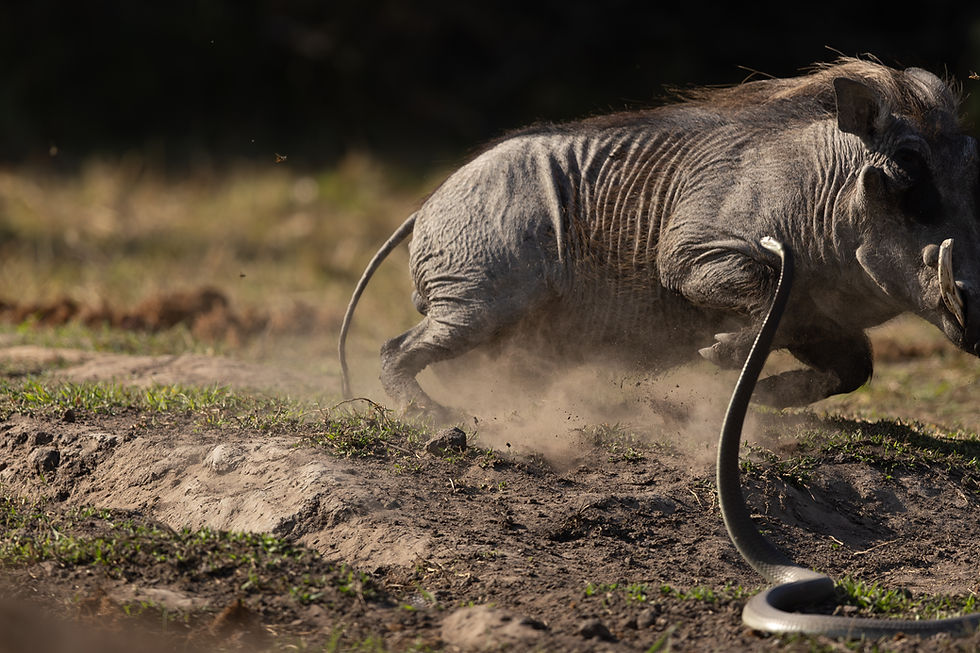Into the Night: Why Zambia's Night Drives are a Safari Must-Do
- Tyrone McKeith

- Apr 29
- 3 min read

There’s something undeniably thrilling about being out in the African bush after dark. The air cools, the stars emerge in numbers you never thought possible, and the bush comes alive with sounds and movements that remain hidden during the heat of the day. Welcome to the night drive—one of Zambia’s most unique and unforgettable safari experiences.
What Exactly is a Night Drive?
Unlike most safari destinations, where strict regulations mean you must return to camp before sunset, Zambia’s national parks allow for game drives to continue into the night. This opens up a whole new realm of wildlife viewing—one that’s seldom experienced elsewhere.
A night drive in Zambia typically begins as an extension of your afternoon activity. After a few hours exploring the bush in the golden light of late afternoon, your guide will find the perfect spot to stop for sundowners—a classic G&T or a chilled beer—as the sun dips below the horizon. Once darkness has fallen, the second half of your adventure begins: the night drive proper.
While some camps used to offer stand-alone night drives after dinner, today it’s more common (and more productive) to explore during the first couple of hours after sunset. This is when animal activity peaks—and when your chances of seeing something truly special are highest.
Why Are Night Drives So Special?
Nighttime in the bush is when many of Africa’s iconic predators are at their most active. Lions, leopards, hyenas, and even smaller carnivores like servals or genets emerge to hunt, patrol their territories, and interact in ways rarely seen in daylight.
But it’s not just about the predators. Night drives reveal a secret cast of characters—rare and elusive nocturnal species that most safari-goers never get a chance to see. Think:
Porcupines waddling across the track,
Honey badgers charging through the undergrowth with characteristic swagger,
Aardvarks snuffling for termites,
Civets and genets slinking through the grass,
Bush babies bounding between trees, their giant eyes glowing in the torchlight.
These animals are nearly impossible to spot during the day, making night drives a vital part of the complete safari experience.

How Do Guides Spot Animals in the Dark?
It’s not about spotting shapes—it’s about spotting eye-shine. Most nocturnal and crepuscular animals have a reflective layer in their eyes called the tapetum lucidum, which glows under torchlight. Guides and spotters are trained to detect different colours, shapes, and sizes of this eye-shine and use it to identify species—often in a split second.
The skill and experience of your guide really shine through (no pun intended) on a night drive. Not only are they able to pick out unusual species quickly, but they also know which animals not to disturb. Ethical guiding means avoiding daytime species that are resting at night, and focusing only on those animals that are naturally active during the dark hours.
The Importance of Ethics: Why We Use Red Filters
At Classic Zambia Safaris, we are deeply committed to low-impact and respectful wildlife viewing—and that’s especially true on our night drives.
We use red filters on our spotlights when viewing animals at established sightings. Red light is far less invasive than white light: it reduces glare, avoids startling the animals, and allows us to observe natural behaviour without interference.
To aid in the initial spotting of wildlife at a distance, we may briefly use unfiltered white light. This allows our guides to pick up eye-shine more effectively and identify potential sightings quickly. Once an animal has been located and we approach the sighting, we immediately switch to the red filter, ensuring minimal disturbance.

A Nocturnal World Awaits
Night drives are not just a novelty—they’re a window into another world. A world of heightened senses, secretive species, and raw nature at its most active. Zambia has long led the way in offering night drives as a standard and ethical part of the safari experience, and we’re proud to continue that tradition.
So when you join us at Classic Zambia, don’t rush back to camp as the sun sets. Stay out a little longer. Let the night wrap around you, let the spotlight sweep the darkness, and see what surprises await on the other side of sundown.



Sad to read this… I agree with the necessity of red light during a hunt, but general use of red filters?? This means a death knell for any good wildlife photography/cinematography during night drives! I experienced that once - never again!
Bwana Mitch